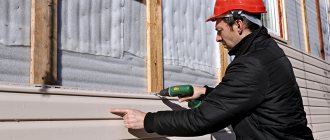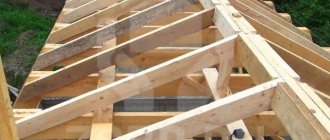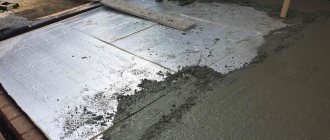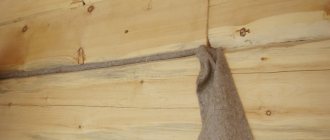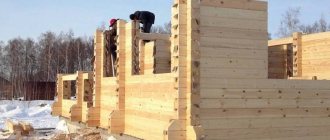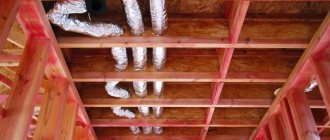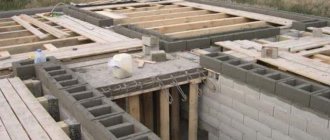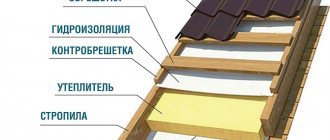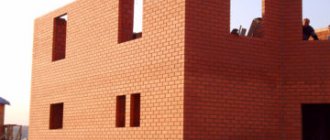Log houses made of rounded logs are in great demand. These building materials retain heat well in the room, have a pleasant appearance, and are environmentally friendly, created from natural material - wood. Thanks to the perfectly even shape of rounded logs, many believe that there is no need to worry about insulating a house made from them. In fact, this is not so, because it is impossible to lay the crowns on top of each other so that there are no gaps between them. Even if they are minor gaps, they will appear; later, after the house shrinks, they will become even larger, and heat will escape through them. It is necessary to insulate cracks using insulating materials immediately during construction and afterwards using caulk.
Caulk
The process of caulking is the driving of insulating material into the inter-crown cracks. This must be done several times:
- immediately after construction;
- a year or 1.5 after the house shrinks;
- 5 years after construction.
For houses made of rounded logs, one caulk, made after the log shrinkage, is sufficient. This process well insulates the seams between the logs, prevents the penetration of cold into the room, the ingress of moisture and freezing of the roof joints. The main thing is to properly insulate the house and use only high-quality insulation materials.
Construction of houses
170 votes
+
Vote for!
—
Vote against!
Have you been told that it is not necessary to caulk a house made of timber, they say, everything fits perfectly there anyway? You can safely send such “woe” specialists home and invite real professionals in the construction of wooden houses. Like any other, the technology of building houses from timber has its own stages and design features, which invariably include caulking of a timber house, even if you are going to subsequently do external and internal finishing with insulation. You should not try to save time and money so as not to overpay in the future. If you don’t want there to be constant drafts in your house, curtains to flutter even in calm weather, and over time wet and rotten places in the wood to appear, it is better to complete all the caulking work at home on time.
- Is it necessary to caulk a log house and why?
- How to caulk a timber house
- When to caulk a log house
- Do-it-yourself caulking of a timber house
- How to caulk a timber house with jute
- Caulking a timber house: video - example
Is it necessary to caulk a log house and why?
In some sources you can find information that a log house does not need to be caulked. And the builders who are building your house can say the same thing. They explain this by the fact that, unlike timber houses, in log houses the shrinkage and displacement of wood occurs stronger and more intensely, cracks and leaks appear, so it is necessary to caulk the structure. But houses built from profiled timber practically do not shrink, since the wood is pre-treated. Let's figure out how it actually happens when building a house from timber with your own hands.
Timber with natural moisture is a relatively cheap building material, which is why it is popular in the construction of economy-class houses with subsequent insulation and finishing with siding. Even if you invite the best architect, he will not be able to build a house from such timber without gaps between the crowns and gaps. Moreover, when the timber begins to dry out, and this is inevitable, additional cracks will appear, wider ones, the timber will decrease in size, and it will begin to “twist”. As a result, cracks will appear, due to which the wooden wall will lose its thermal insulation abilities. To avoid such a sad end, the walls must be caulked at least 3 times and thoroughly insulated.
Profiled timber was invented precisely in order to reduce costs and time for building a wooden house. It undergoes special processing in production, due to which it practically does not dry out during operation, and its tongue-and-groove connections are perfectly aligned to the nearest millimeter. The beams fit together as closely as possible, and 5 mm insulation is placed between the crowns, which is located between the interlocking parts. Despite the seller’s assurances, the house made of profiled timber still shrinks, as the timber finally falls into place under the weight of the structure. In addition, the properties of wood greatly depend on the region of growth, climatic conditions and storage conditions. No one can guarantee that absolutely all the timber you purchased is of the same high quality. As a result of building movements, the timber may shift slightly and the insulation may become wrinkled. Even if no gaps appear after shrinkage, and this option is possible, still those gaps that are located in the inter-crown space outside and inside the house accumulate moisture, and since the place itself is very secluded and vulnerable, mold and rot can form in it.
Caulking a timber house is necessary in order to insulate wooden walls, completely filling them with natural insulation and sealing the gaps and cracks between the beams and in corner joints. This guarantees tightness, no heat leaks through the walls, drafts and icing of the timber outside the building, which occurs when warm steam escapes through the cracks and settles as wet frost on the surface.
How to caulk a timber house
To summarize, the material that can be used to caulk a house must meet the following requirements:
- Have low thermal conductivity.
- Be immune to temperature and humidity fluctuations, and easily withstand wind.
- So that insects and pathogenic fungi (mold) do not grow in it.
- Be an absolutely environmentally friendly material, otherwise the whole point of building a wooden house is lost.
- Be relatively durable (not lose properties for at least 20 years).
- Be breathable.
- Be hygroscopic, i.e. when you need to absorb moisture, when you need to give it away.
- And the most important thing is to be similar in its properties to wood.
Due to the fact that our ancestors caulked their houses hundreds of generations deep on their own, materials that have been tested and tested by thousands of years of successful practice have survived to this day. They can be called traditional materials.
Moss is the best material even today for caulking wooden buildings. This is sphagnum moss, a bog plant that can be red, white or brown. Subsequently, peat is formed from it. None of the modern materials can compare with moss, it is so durable and environmentally friendly. You can travel through old abandoned villages, look at the houses: the logs have almost rotted, and the moss is still in excellent condition. Moss is simply irreplaceable as an interventional sealant: it has antiseptic, antibacterial and healing properties. Sandwiched between wood, it suppresses the development of putrefactive bacteria and mold fungi, due to which the wood lasts longer. Moss easily allows air to pass through itself, which, passing through it, is saturated with healing vapors, so the atmosphere inside the house becomes healing. Moss is hygroscopic, which means it smoothes out changes in humidity. In general, moss has no drawbacks, except for one thing - it is not so easy for them to caulk, otherwise no one would invent or look for anything new.
Tow made from flax fibers is used as a sealant and sealant everywhere, but for caulking - mainly in regions where flax grows and where there are no swamps where moss could be stocked. No one produces tow specifically; it is waste from the production of ropes, cords and linen, or tweezing and stripping after cleaning flax fibers. Tow has some antiseptic and bactericidal properties, but to a lesser extent than moss. Therefore, in some cases, tow is treated with resins to increase resistance to high humidity. These resins can be natural, i.e. tree resins, then this material can still be called environmentally friendly, but petroleum products are also used for impregnation, then tow no longer has anything in common with natural materials. The tow contains a large amount of fire, which will be shaken out during the first years of operation of the house, so the caulk will need to be repeated several times.
Hemp hemp is very similar to tow, only its fibers are coarser, so they are sometimes confused. Hemp is not afraid of temperature changes and high humidity, so it can be used even in very humid regions. These properties are due to the high content of the polymer lignin, which is also found in any wood to bind cellulose fibers. Hemp does not lose its properties even after getting wet, therefore it is resistant to rotting.
Among the modern materials for caulking, the following can be distinguished:
Jute is a foreign product; it is imported to us from China, India, Egypt and other countries with a tropical climate or heavy rainfall. It is produced from the shoots of the jute plant of the Malvaceae family. Jute fiber is very durable, not affected by mold, putrefactive bacteria, not interesting to insects and birds, hygroscopic, i.e. easily accumulates and releases moisture, allows air to pass through. Jute contains about the same amount of lignin as wood, so their properties are similar and together they are a perfect pair.
Jute is produced both in fibers and in strips of different widths. Tape jute insulation is very convenient to use for laying between the crowns of a log house. In addition, pure jute compacts evenly. These advantages more than cover the price of this material.
In addition to materials made from fibers, felt insulation materials (inter-crown felt) are also used for caulking:
Jute inter-crown insulation consists of 90% jute and 10% flax. But it is better to follow this ratio, since there is jute felt that consists of 70% jute and 30% flax, which significantly worsens its properties.
Linen felt is also called eurolin or flax wool. It is a needle-punched material made from highly purified flax.
Flax-jute felt consists of jute and flax in a 1:1 ratio.
All-jute modern insulation materials are considered the best, since they interact perfectly with wood and shrink evenly, while other materials with the addition of flax worsen the properties of the insulation. The more flax, the worse the properties.
When to caulk a log house
Work on caulking a house is carried out in several stages, this is due to the fact that the timber dries out gradually, the house sinks under its own weight. The largest shrinkage occurs in the first year and a half after construction, and every year it is less and less. Experts say that after 5–6 years, shrinkage practically stops.
The first time a timber house is caulked immediately after construction. During the construction process, insulation is laid between the crowns, and after the entire house is erected, the gaps between the beams are filled with caulking material, but not too tightly.
The second caulking is done a year and a half after the completion of the house. The house will already have settled, so it is necessary to caulk tightly, leaving no gaps or hanging material.
The third time the caulking work will have to be done again after 5 - 6 years, carefully filling all the newly formed gaps and cracks and adding material where it accidentally spilled out or was pulled out by birds.
If it is planned to cover the outside of a timber house with siding, then the third caulking is not performed, but the first two must be completed. There is no need to rush and save on something for which you will later have to pay much more.
Do-it-yourself caulking of a timber house
Caulking is a very responsible and labor-intensive process, despite some monotony of the operations performed. Not many construction crews agree to do caulking work; they simply don’t know how to do it and are afraid of ruining it, which is why they recommend not caulking at all. We have already discussed why you should not listen to them.
But there are teams and entire organizations that deal with caulking professionally. The price for caulking a timber house depends on the stage of work and amounts to a certain amount per 1 linear meter of each crown. The average cost of caulking is 50 – 60 rubles. for 1 m.p. And caulking corner joints can cost up to 200 rubles. for 1 m.p. At a separate rate, caulking will be carried out with a decorative rope (rope), which decorates the appearance of the caulked walls and prevents birds from pulling out the material. By the way, it is customary to pay for the material separately. If you are offered to perform caulk work for 25 rubles. m.p., you should not agree, since the work will be done extremely poorly.
If you want to do all the work yourself, then stock up on patience, material, tools and subsequent information.
How to caulk a timber house with jute
Jute, as a material for insulating a log house, is gaining wild popularity. It is often used in the construction of the house itself.
Before caulking a timber house, you must first properly lay and secure the timber. Insulation is always laid in the inter-crown space with a layer of at least 5 mm. Even if the beam is profiled, jute must be laid between the tenon and groove. But its width depends on the shape of the tongue-and-groove system. The simplest option is when the lower beam has a surface convex with a crescent, and the upper one has the same notch (somewhat reminiscent of a joint of logs), in which case the space between the crowns is completely filled with insulation, and its edges remain hanging 4 - 5 cm on each side. A more complex version of profiled timber, when it is impossible to lay the insulation with a continuous carpet, then it is laid only in the middle, and the external and internal cracks are then caulked separately.
If the house is made of timber with natural humidity, then the thickness of the inter-crown insulation should be 10 - 15 mm.
Important! Caulking must be done from top to bottom. In this case, first one crown is caulked completely outside, then inside, and only then they move on to the second crown. It is better if the work is carried out by 4 people simultaneously on 4 walls. This is necessary to ensure that the house does not warp. After all, after caulking is completed, it will rise by several centimeters, from 5 to 15 cm.
Let's consider the option when the insulation hangs between the beams by 4 - 5 cm. The caulking technology is very well shown in the video example. Using a caulking tool (tool), the jute is tucked underneath and lightly pushed into the gap. Then it is gently, but more forcefully pushed in the upper part, and finally - in the middle. To push the material inside the crack, use a rubber or wooden hammer (mallet), which is gently hit on the caulk.
If, after the work has been completed, loose cracks are still observed, then additional caulking is performed.
Let's consider the option when the gaps between the crowns are not filled (the insulation is located somewhere in the middle of the beam). The work will be exactly the same as with additional caulking.
Usually the gaps between the beams are quite narrow, so this caulking method is used: a rope as thick as the gap is twisted from jute fiber and hammered into the gap with a mallet.
There is another way - “stretching”. Separately taken fibers of jute are laid in fibers across the beam and pushed inward with a spatula or caulk until the gap is completely filled. We leave the remaining ends of the material hanging, it should be about 5 - 6 cm. Next, take a little more jute, roll it into a ball (roller), which is wrapped in these hanging ends and pushed into the gap.
Important! How can you check whether it’s enough to push the insulation in or if you still need to add a little more? If a kitchen knife fits 15 mm or less into the gap between the crowns, then the caulking has been done successfully. If the knife goes further, then material should be added.
When large cracks are formed, use the “set” caulking method. Long strands of jute are twisted and rolled into a ball. Loops are then made from the ball and pushed into the cracks until they are filled.
After all caulking work is completed, the house is loaded and, if possible, used for a whole year. In winter, it will be possible to check for the presence of cracks using the so-called “hares”. These are pockets of frost on the outside of the wall. If you find them, mark the place, this means that there is a leak of warm air from the house. A year to a year and a half after the first caulking, a second caulking is carried out, the house is carefully inspected, insulation is added to those places where it has spilled out or frayed, where the cracks have widened, where the timber has warped, and also in places where there are “hares”.
Only after re-caulking can you begin the exterior and interior decoration of the house. Even if it involves 100 mm of mineral wool and a ventilated façade.
You can caulk a timber house with other materials. But there are some exceptions. For example, only a house made of non-profiled timber can be caulked with moss, since this material is laid and completely fills the inter-crown space, which is absolutely impossible if the timber has a tongue-and-groove system. The work itself on caulking a house is complex and painstaking, although from the outside it seems painfully simple. If you are not confident in your abilities, invite a specialist.
Caulking a timber house: video - example
Artificial insulation materials
Artificial materials include:
- Mineral wool, glass wool and other fibrous mineral wool insulation. They are environmentally friendly, but can still lead to the development of allergic reactions in residents. They provide good insulation and prevent rodents from growing in them. But these insulation materials are not hygroscopic and even to be afraid of moisture, it worsens their basic characteristics.
- Foamed polyethylene and other closed-cell insulation materials. Materials made from it insulate the inter-crown seam well. They keep the cold out and keep the heat out. But at the same time they don't breathe. They can be compared to a plastic bag, creating a greenhouse effect in the inter-crown joint, this can lead to damage to the wooden material and its rotting.
- Foam rubber and other open-cell insulation materials. These insulation materials are not able to protect the crown joint from freezing. Despite the fact that air and moisture are able to penetrate into the small pores of the material, under the weight of the upper crowns of the log house they are compressed, and the result is a non-breathable, homogeneous mass of insulation.
Many artificial insulation materials cope well with their thermal insulation tasks. But it is advisable to use them for structures built from bricks, concrete, cinder blocks and other mineral building materials. These insulation materials are not suitable for wood; they will shorten its service life, worsening its strength characteristics.
Necessary equipment for work
Tools for caulking log houses.
Is it necessary to caulk a log house? Yes, this is necessary, because a correctly carried out process will eliminate cracks in the space between the timber and at the connection points of the crowns, heat will be retained in the room, drafts and icing will not appear there.
The material used for caulking must meet certain requirements. In terms of quality indicators, it should be similar to wood and have a clean, environmentally friendly base. Such raw materials are not characterized by changes in external data under the influence of high humidity and temperature indicators. Air should not pass through it; at the same time, the source must absorb moisture from the surrounding air and get rid of it in a timely manner. Such material should be free of rot or pests. An important indicator of such a source will be the preservation of valuable indicators for as long as possible.
Article on the topic: Garden house 15 sq. m
Among the materials used for insulating the seams of houses, swamp moss-sphagnum, flax tow, and hemp have long been used. Modern achievements in the construction field have provided a new material, jute, for mass use. One of the best options is swamp moss, which reliably protects the walls of the building from putrefactive processes and fungal manifestations.
Types of caulk.
As a result, buildings last much longer. Moss is able to actively absorb moisture, and if the need arises, it saturates the wood with it. Its base is highly breathable and has antiseptic properties. Moss can be considered an ideal material for caulking. However, it is quite difficult to finish seams in a log house with it. And it’s not easy to collect such raw materials in the required volume.
Flax tow and hemp are also used for caulking at home, but their quality indicators are much lower than the considered option. These options are classified as industrial waste, have a similar structure, hemp has thicker and stronger fibers. The disadvantage of such materials is the residue in the form of fires; over time, it begins to crumble, and there is a need for repeated work.
Jute is an imported product; it has been used in construction not so long ago. Any house will be reliably caulked with this type of material, providing it with special strength, hygroscopicity, and excellent air conduction. Jute is not capable of rotting or molding; its strong base does not allow birds to pull fibers out of cracks, which is often observed when using tow and hemp.
Jute is sold in strips and fibers. The first form creates comfortable conditions for defining them in the space between the crowns in the log house. Pure jute fiber helps in constructing a uniform compaction. But such material will have a fairly high price. To reduce its cost, flax becomes a component of jute, which does not have the best effect on its quality indicators.
Article on the topic: Alphabet cross stitch patterns: Russian and English, embroider metrics for free, floral very beautiful
Natural insulation materials
Natural interventional insulation materials include:
- Moss. This is the best insulation. It was used for caulking hundreds of years ago. It does an excellent job of insulating a home. It has good hygroscopicity, capable of absorbing moisture more than 20 times its own size. The structure of moss fibers contains lignin, which prevents rotting and damage to the insulating material and the logs themselves. It has bactericidal properties and will destroy bacteria in the air in the room.
- Jute. Its properties resemble moss, but it is easier to work with. The density of jute is good and does not allow heat or cold to pass through. This material breathes and is hygroscopic. The appearance is also different; jute has a golden color, similar to the shade of wood. In interventional seams it looks beautiful and aesthetically pleasing.
- Linen. This is a cheaper material, but its properties are worse. He is afraid of constant contact with moisture, which can lead to rotting. The shade of this material is gray. The density is not great, linen feels softer to the touch. It is advisable to use this insulating material for insulating houses built from dry wood; it is perfect for laminated veneer lumber.
- Lnovatin. Good insulation is made from jute and flax. These two materials together create excellent insulation, which includes their positive qualities. Linen wool is resistant to external influences, has good density and the ability to restore its size. If the wooden material dries out, this insulation fills all the voids in the inter-crown space of the rounded log.
Tool
Caulking a wooden frame for a long service life is not one of those jobs that can be done with improvised means. In the old days, many temporary log buildings, for example, hunting lodges, barns, etc., were hastily caulked with an ax and a blunt chisel or a piece of wood. She went to dig - well, we’ll stuff more, God knows what. But now a log house is an expensive pleasure and an indicator of prestige. Caulking a finished, occupied house is difficult and greatly reduces its service life, so when you decide to build a log house, you need to purchase a caulking tool.
Caulking tool
The most commonly used caulking tool is steel, top left in Fig. Stacked and curved caulking is needed, as shown there, for both primary and secondary caulking (see below): wedge-shaped and narrow are the corners, and curved caulking is tucked into the cracks; It is better to also have two curved caulks: approx. 8 and approx. 3 cm. Using road caulking, install a ribbon of jute or a strand (bundle) of tow for secondary caulking. Breaking caulking tools are also called wedges (not to be confused with a wedge tool for punching caulking seams in the hulls of wooden ships); they are used to remove old caulking when re-caulking; sometimes they “trample down” the secondary, see below.
Note: it is very convenient to caulk with an electric caulking tool (bottom left in the figure) with replaceable tips. Electric drills are available for rent, but there is no need to attach homemade tips to an electric or pneumatic hammer drill - it hits too hard, it will tear the caulk and damage the wood.
A very important tool is the wooden mouchel mallet. The mushel is constructed in the same way as a wooden leopard sledgehammer, but lighter, 0.8-1 kg, for which reason its firing pin is made of a smaller diameter. The blow with a mouchel is strong, but soft, without noticeable recoil, which is especially important when caulking with flax and jute. But hitting the caulk with the butt of an ax or a blacksmith’s sledgehammer is unacceptable; With a carpenter's hammer, instead of a mouchel, it is possible to use for caulking the jute of a log house made from a solid rounded log, in the center in Fig.
If you are going to caulk with moss, it would be better to stock up on hardwood caulks, straight and oblique, and a mallet instead of a mouchelle: a steel tool tears up soft moss too much, and you won’t get a high-quality caulk. Wooden caulking tools soon wear out; for a frame of 12 crowns you will need 3-4 sets of caulking and 2-3 beaters, for which on the right in Fig. Their drawings are given: wooden caulking is not easy to find on sale, and buying them is expensive.
Expert advice
The caulking process is not easy. It’s better not to do it alone. The insulation material must begin to be hammered in from the lower inter-crown seams and gradually rise higher. Caulking needs to be done around the entire perimeter of the house at once, and not to first completely insulate one wall and then move on to another, otherwise the walls may squint or even slide off the fastening element, for example, a dowel.
For caulking a wooden house made of rounded logs, it is best to use natural materials. They complement the wooden material, improving rather than degrading its characteristics. If you have no experience working with insulating materials, and you can’t cope with caulking, you can use an alternative insulation method - sealing.
Caulking technology
There are two main caulking methods:
- “Stretched.” The material is pushed into the gap using a special tool, tightly filling it with insulation. The remaining material is wrapped in a roller, which is pushed firmly into the unfilled space between the logs.
- "Recruiting." This method is used to seal wide cracks and gaps. The material is twisted into strands, which are then folded into loops. The loops are pushed into the holes between the logs and fill the free space with them.
Regardless of the caulking method used, proper caulking always starts with the lowest row of logs. Next, we will look in detail at how to properly caulk a log house.
Stretched caulk
Caulk with fiber insulation
- Caulking begins from the ends of the bottom row. Take a bunch of moss or tow in your hands and apply it across the fibers to the crack, then press it inward with a caulking blade.
- The edges of the fibers are rolled into a tight roll, applied to the seam and pushed into the cracks with caulk, leaving the end hanging outside.
- Take new strands of tow, weave them into the free edge of the roller and repeat the steps in the same sequence. You need to caulk the entire seam tightly and evenly. Therefore, it is very important that the roller is not interrupted and is continuous along its entire length.
Caulking with roll material
When using tape insulation, it is much easier to twist the roller. The material is stretched slightly along the seam, which allows the insulation to be distributed more evenly. The material must be applied to the seam across the fibers; with a longitudinal arrangement, it is impossible to achieve the required density.
- The tape is unwound from one corner of the log house to the other, without tension, but leaving it to lie freely on the ground.
- Take the tape by the edge and use caulk to push the middle of the material into the seams between the logs, leaving the edges hanging down by 5-7 cm. Fill the entire seam in this way.
- Once the entire seam is initially filled, you can cut the tape from the roll.
- Hammer the remaining material into the gaps between the beams. The caulked seam should be of uniform density and thickness and should protrude approximately 4mm from the grooves.
Caulk "set"
In this way, as a rule, wide cracks are caulked. In this case, more insulation is required, but the quality of insulation is much higher. To do this, use tow, from which long strands are made and wound into a ball. You can trim the log house with jute cords or hemp ropes, which are also used to form balls.
- Unwind a little cord and fold it into loops, which are alternately pushed into the seam with caulk.
- The hinges are hammered in with caulking, first from the top of the gap, and then from the bottom.
- Another strand is placed on top, with which the final compaction is made, then the strand is leveled with a triangular caulk.
To make the work a little easier and fill in the insulation faster, the process can be mechanized. To do this, the log house is caulked using a hammer drill, which is used instead of a traditional tool. But while working, you cannot put too much pressure on the hammer drill, otherwise its blade may get stuck between the logs, and you also need to take a break every 20 minutes. You can also use a pneumatic hammer with a compressor to hammer in the insulation.
To give the seams a neat and beautiful look, you can finish the log house with jute rope on top of the caulk. The finishing does not insulate the house, but is done purely for decorative purposes. How to attach a rope for finishing a log house? The decorative cord is attached using galvanized nails without heads, which are driven into the upper and lower logs in 20 cm increments.
Sanding and painting the house is done after secondary caulking. How and with what to paint a log house can be read in the article: “How to properly paint the facade of a wooden house.”
Caulking corners
The corners are caulked after the main caulking is completed. It is more convenient to do this using roll insulation.
- The edge of the tape is applied to the corner seam and pushed inside using a curved caulk.
- After securing the material, fold its edges and hammer it tightly into the cracks.
- During work, move from the top seam to the bottom. In order for the material to lie evenly, it needs to be stretched a little and constantly straightened.
How to check the quality of log caulking? The tightness of internal and external seams can be checked using a chisel or other sharp object that should not pass through the caulk. The insulation should lie tightly, and the caulked seams should look neat and secure.
Sealing of inter-crown seams
Sealing seams is easier and faster than caulking using sealants. It is easier to work with them than with insulating inter-crown materials. Neomid's sealed formulations have proven themselves well: Word Professional and Word Professional plus. These products are very similar to each other, but only the second sealant is more elastic and can be applied to surfaces with a large angle of inclination. Otherwise they are no different.
Neomid sealants have good adhesion, excellent adhesion to wooden material and excellent elasticity. Sealed compounds are applied using a construction gun. The sealed seam is not afraid of weathering, moisture, does not turn yellow under the influence of sunlight, and mold does not form on it.
How to caulk a timber house
Caulking is carried out in three stages.
For the first time, when the house was just built. The insulation is placed between the crowns and laid in the cracks.
The second time they caulk the already weathered and settled house. This happens about a year and a half after construction. The insulation is pushed in tightly, leaving no space.
The third caulking should be done after 5-6 years, when the shrinkage of the house has almost stopped. If before this it was not additionally insulated from the outside and not covered with finishing.
There are several options for caulking a timber house.
Caulk stretched and in a set
The stretching method is used for narrow gaps and cracks in timber.
They use a special tool called a caulk and a mallet.
They start the process from the upper crowns, move down, pass one seam on the outside and inside. To prevent the house from warping, it is better to work on all four walls at the same time.
First, the insulation is laid by hand, then it is pushed deeper with caulk, and finally it is hit with a mallet to compact the insulation. Continue until the shoulder blade enters the gap less than one and a half centimeters.
Sometimes a wide strip of insulation is laid between the beams during the installation of walls, so that it hangs on both sides. And then they push her inside.
After completion of the work, the height of the log house will increase by ten centimeters.
If the gaps have formed more than two centimeters, choose the “in-set” method. They cut off the insulation tapes and twist them into bundles, the bundle is folded into loops, then pushed deep into the crack. This way all free space is filled. The final tape is applied on top and compacted using a triangular spatula.
Customer reviews
Several years ago, my family and I built a country house from rounded logs. During construction, insulation material was laid between the crowns. At this point, I decided that we had sorted out the insulation of the house. But for a year, our neighbor insisted that I caulk all the walls after the house was completely settled. As a result, he persuaded me.
We chose the materials for the upcoming work together and purchased inexpensive but quite good flax wool insulation in the form of tow. The work was not easy, it took us three days, while we insulated the house with our neighbor from early morning until evening. I’ll say right away that caulk is for diligent and attentive people. We noticed minor cracks on the rounded log; we had no desire to caulk them, but they spoiled the appearance of the house, so we had to get rid of them. To eliminate them, the hardware store offered a sealed composition of domestic production, and with it the work progressed much faster. If it weren't for our neighbor, our family would have had to freeze on cold winter days. And the house we caulked is now very warm and cozy.
Anatoly Kosenko, 27 years old (Barnaul).
What is the difficulty of self-caulking?
Despite its apparent simplicity, caulking is a job that requires experience and special knowledge. There are many nuances in caulking that are known only to professional caulkers. The work is performed exclusively by hand, so the quality of caulking depends entirely on the skill and professionalism of the performer.
Of course, you can purchase the necessary materials and caulk the house yourself, but a lack of experience will certainly affect the final result. Many people wonder: can caulk fall out after heating a log house or carriage? It depends on how well the work is done. If during caulking the technology is violated and the insulation is not sufficiently secured, then it is quite possible that after heating it will fall out.
Birds will quickly carry the caulking done ineptly with tow into their nests. Professional craftsmen insert the material in such a way that birds cannot reach it and pull it out. If the sequence of work is violated, the inter-crown material is incorrectly laid, or insulation of different thicknesses is used, deformation of the structure is possible. In this case, you will have to caulk the house again. As for labor costs, caulking is not an easy job; an amateur will have to put in a lot of effort and spend quite a lot of time to caulk his house.
Procedure for caulking a log house
Scheme of caulking of a log house with tow.
The log house needs to be caulked twice: immediately after installation and after it has experienced shrinkage. After a few years, you need to check the condition of the gaps between the beams. It is possible that in some places the insulation will need to be replaced.
When using any material to plug the cracks, you will need several wooden spatulas with a flat tip and a hammer. The material is inserted into the gaps between the beams with a spatula, and you need to tap it with a hammer so that it penetrates deep. But you don’t need to knock very hard, otherwise the gap will simply become larger.
After installing the log house on the foundation, you need to start plugging the gaps. Next, you should prepare the necessary tools, select the material, and calculate the required quantity. You will need to calculate the perimeter of the building, multiply it by the number of joints between the beams and subtract the width of the window and door. Remember that you need to caulk not only from the street, but also from inside the room, which means the resulting number needs to be doubled.
Caulking of a log house with any material begins from the lowest joint. It is necessary to seal the lowest gap on all walls around the perimeter of the building, first from the outside and then from the inside. Next, we seal the gaps between the second and third beams of the walls, etc. This is due to the fact that when caulking, the height of the wall increases. If you do the work unevenly, the entire frame will become warped.
